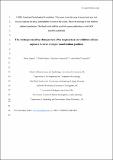Files in this item
The strategies used by chimpanzees (Pan troglodytes) and children (Homo sapiens) to solve a simple coordination problem
Item metadata
| dc.contributor.author | Duguid, Shona | |
| dc.contributor.author | Wyman, Emily | |
| dc.contributor.author | Grueneisen, Sebastian | |
| dc.contributor.author | Tomasello, Michael | |
| dc.date.accessioned | 2020-05-25T09:30:02Z | |
| dc.date.available | 2020-05-25T09:30:02Z | |
| dc.date.issued | 2020-05-21 | |
| dc.identifier | 267454148 | |
| dc.identifier | fadb81b9-db9f-4ea8-a9b1-d52aad01f96c | |
| dc.identifier | 85087048200 | |
| dc.identifier | 85087048200 | |
| dc.identifier | 000592947000006 | |
| dc.identifier.citation | Duguid , S , Wyman , E , Grueneisen , S & Tomasello , M 2020 , ' The strategies used by chimpanzees ( Pan troglodytes ) and children ( Homo sapiens ) to solve a simple coordination problem ' , Journal of Comparative Psychology , vol. Online First . https://doi.org/10.1037/com0000220 | en |
| dc.identifier.issn | 0735-7036 | |
| dc.identifier.other | ORCID: /0000-0003-4844-0673/work/74873186 | |
| dc.identifier.uri | https://hdl.handle.net/10023/19987 | |
| dc.description | The authors acknowledge support from the ESRC Network for Integrated Behavioural Science – ES/K002201/1. | en |
| dc.description.abstract | One of the challenges of collaboration is to coordinate decisions with others, and recent theories have proposed that humans, in particular, evolved skills to address this challenge. To test this hypothesis, we compared the coordination abilities of 4-year-old children and chimpanzees with a simple coordination problem. To retrieve a reward from a “puzzle box,” pairs of individuals were simply required to choose the same 1 of 4 options. If successful, they each received the same reward, so there were no conflicts of interest. Individuals were paired with multiple partners over time. Both species were able to coordinate, but there were marked differences in the way they did so. Children were able to coordinate quickly and flexibly, adjusting easily to new partners, suggesting an understanding of the coordination process. In contrast, chimpanzees took time to converge on a single solution with each new partner, with no gains across partners, suggesting that their coordination was based only on repeating successful past choices. Together, these results support the hypothesis that humans have evolved unique skills for coordinating decisions and actions with others in the pursuit of common interests. | |
| dc.format.extent | 12 | |
| dc.format.extent | 1005944 | |
| dc.language.iso | eng | |
| dc.relation.ispartof | Journal of Comparative Psychology | en |
| dc.subject | Cooperation | en |
| dc.subject | Coordination | en |
| dc.subject | Communication | en |
| dc.subject | Chimpanzees | en |
| dc.subject | Children | en |
| dc.subject | BF Psychology | en |
| dc.subject | Ecology, Evolution, Behavior and Systematics | en |
| dc.subject | Psychology (miscellaneous) | en |
| dc.subject | DAS | en |
| dc.subject.lcc | BF | en |
| dc.title | The strategies used by chimpanzees (Pan troglodytes) and children (Homo sapiens) to solve a simple coordination problem | en |
| dc.type | Journal article | en |
| dc.contributor.institution | University of St Andrews. School of Psychology and Neuroscience | en |
| dc.identifier.doi | https://doi.org/10.1037/com0000220 | |
| dc.description.status | Peer reviewed | en |
| dc.date.embargoedUntil | 2020-05-21 | |
| dc.identifier.url | https://psycnet.apa.org/fulltext/2020-33496-001.html | en |
This item appears in the following Collection(s)
Items in the St Andrews Research Repository are protected by copyright, with all rights reserved, unless otherwise indicated.

